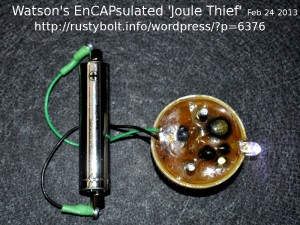 There are many other uses for common household items, or even stuff that would otherwise go to the trash or recycling. In this case, I built a two transistor “Joule Thief” V Booster on a small perf board, put it inside of a soda bottle cap along with two screws and encapsulated it in epoxy – that’s why it’s enCAPsulated. The photo shows the choke with a single winding, labeled ‘104’ for 100 microhenrys. The epoxy has turned a bit dark with age. I use the term ‘Joule Thief’ but it’s not a true Joule Thief.
There are many other uses for common household items, or even stuff that would otherwise go to the trash or recycling. In this case, I built a two transistor “Joule Thief” V Booster on a small perf board, put it inside of a soda bottle cap along with two screws and encapsulated it in epoxy – that’s why it’s enCAPsulated. The photo shows the choke with a single winding, labeled ‘104’ for 100 microhenrys. The epoxy has turned a bit dark with age. I use the term ‘Joule Thief’ but it’s not a true Joule Thief.
This circuit uses two transistors because I built it back in the early 2000s (might have been Oct 2003) before I had learned how to get a single transistor to put out enough current to light the LED to full brightness, or about 20 milliamps. Instead, I used the conventional two transistor circuit and a choke with a single low resistance winding. I had only had limited experience with winding toroids, and I didn’t have enough experience to know what kind of core to use or how to wind it with heavier low resistance wire. I remember the chokes cost about a dollar apiece. Nowadays, I can wind a toroid core with two short lengths of telephone wire for about 12 cents.
The two screws were to anchor it down in an outside environment; the epoxy was for protection against the weather. Later I found that the transistor has to be capable of handling very high current at low voltage, and that meant the transistor has to be chosen for that purpose – many transistors are not capable. The wisdom of Joule Thief building came to me after a few years, and I learned from experimenting and experience that if I wanted to see good Joule Thief performance, I had to understand how they worked and what to use for components. I guess I could call it the Care and Feeding of Joule Thiefs. I thought about authoring a book, which would consist mostly of the blogs I had written about Joule Thiefs in my late watsonseblog. But it went away, thanks to the BOFHs at blogger.
But back to this circuit. The LED is very bright and can be seen even though the camera’s flash is very bright. I built several of these same circuits, and put them in Velamints tins (a miniature Altoids tin). One of them can be seen in my blog here.
Back to experimenting…